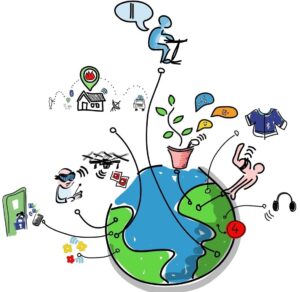The Role of IoT in Industrial Automation
The Fourth Industrial Revolution, often referred to as Industry 4.0, is characterized by the integration of advanced technologies into manufacturing and industrial processes. At the heart of this transformation is the Internet of Things (IoT), which is reshaping how industries operate by enabling machines, devices, and systems to communicate and collaborate in real-time. This article explores the pivotal role of IoT in industrial automation, its benefits, challenges, and future prospects.
## Understanding IoT in Industrial Automation
The Internet of Things refers to a network of interconnected devices that communicate and exchange data over the internet. In the context of industrial automation, IoT encompasses a wide range of technologies, including sensors, actuators, cloud computing, and data analytics. These technologies work together to create smart factories where machines can monitor their own performance, predict maintenance needs, and optimize production processes.
### Key Components of IoT in Industrial Automation
1. **Sensors and Actuators**: Sensors collect data from machines and the environment, such as temperature, pressure, humidity, and vibration. Actuators, on the other hand, are devices that perform actions based on the data received, such as adjusting a valve or starting a motor.
2. **Connectivity**: IoT devices rely on various communication protocols, such as Wi-Fi, Bluetooth, Zigbee, and cellular networks, to transmit data to centralized systems for analysis.
3. **Data Analytics**: The vast amounts of data generated by IoT devices are analyzed using advanced analytics and machine learning algorithms. This analysis provides insights that can drive decision-making and process optimization.
4. **Cloud Computing**: Cloud platforms enable the storage and processing of large datasets, allowing for scalable and flexible data management solutions.
5. **Edge Computing**: In some cases, data processing occurs closer to the source of data generation (the “edge”) to reduce latency and bandwidth usage, enabling real-time decision-making.
## The Benefits of IoT in Industrial Automation
### 1. Enhanced Operational Efficiency
One of the most significant advantages of IoT in industrial automation is the enhancement of operational efficiency. By continuously monitoring equipment performance and production processes, manufacturers can identify bottlenecks, reduce downtime, and optimize resource allocation. For example, IoT sensors can detect anomalies in machine performance, allowing for proactive maintenance before a failure occurs.
### 2. Predictive Maintenance
Traditional maintenance practices often rely on scheduled maintenance or reactive approaches, which can lead to unexpected downtime and costly repairs. IoT enables predictive maintenance by analyzing data from sensors to predict when equipment is likely to fail. This allows manufacturers to schedule maintenance activities at optimal times, reducing unplanned downtime and extending the lifespan of machinery.
### 3. Improved Quality Control
IoT technologies facilitate real-time monitoring of production processes, enabling manufacturers to maintain high-quality standards. By collecting data on various parameters, such as temperature, humidity, and pressure, manufacturers can ensure that products meet specifications. If deviations occur, immediate corrective actions can be taken, reducing waste and improving overall product quality.
### 4. Increased Flexibility and Agility
In today’s fast-paced market, manufacturers must be agile and responsive to changing customer demands. IoT enables greater flexibility in production processes by allowing for real-time adjustments based on demand fluctuations. For instance, smart factories can quickly reconfigure production lines to accommodate different products or batch sizes, enhancing responsiveness to market changes.
### 5. Enhanced Supply Chain Management
IoT plays a crucial role in optimizing supply chain management by providing real-time visibility into inventory levels, shipment status, and production schedules. This transparency allows manufacturers to make informed decisions regarding inventory management, order fulfillment, and logistics. For example, RFID tags and IoT sensors can track the movement of goods throughout the supply chain, ensuring timely deliveries and reducing stockouts.
### 6. Energy Efficiency
Energy consumption is a significant cost factor in industrial operations. IoT technologies can help monitor and optimize energy usage across manufacturing facilities. By analyzing energy consumption patterns, manufacturers can identify inefficiencies and implement strategies to reduce energy waste. For instance, smart lighting and HVAC systems can adjust based on occupancy and environmental conditions, leading to substantial energy savings.
## Challenges of Implementing IoT in Industrial Automation
While the benefits of IoT in industrial automation are substantial, several challenges must be addressed for successful implementation.
### 1. Data Security and Privacy
As IoT devices collect and transmit vast amounts of data, concerns about data security and privacy become paramount. Cybersecurity threats, such as hacking and data breaches, can compromise sensitive information and disrupt operations. Manufacturers must invest in robust security measures, including encryption, access controls, and regular security audits, to protect their IoT systems.
### 2. Integration with Legacy Systems
Many manufacturing facilities rely on legacy systems that may not be compatible with modern IoT technologies. Integrating IoT solutions with existing infrastructure can be complex and costly. Manufacturers must carefully plan their IoT implementation strategies, considering how to bridge the gap between old and new technologies.
### 3. Data Management














Post Comment